TetR-family transcriptional repressor Thermus thermophilus FadR controls fatty acid degradation.
Agari, Y., Agari, K., Sakamoto, K., Kuramitsu, S., Shinkai, A.(2011) Microbiology (N Y) 157: 1589-1601
- PubMed: 21349973
- DOI: https://doi.org/10.1099/mic.0.048017-0
- Primary Citation of Related Structures:
3ANG, 3ANP - PubMed Abstract:
In the extremely thermophilic bacterium Thermus thermophilus HB8, one of the four TetR-family transcriptional regulators, which we named T. thermophilus FadR, negatively regulated the expression of several genes, including those involved in fatty acid degradation, both in vivo and in vitro. T. thermophilus FadR repressed the expression of the target genes by binding pseudopalindromic sequences covering the predicted -10 hexamers of their promoters, and medium-to-long straight-chain (C10-18) fatty acyl-CoA molecules were effective for transcriptional derepression. An X-ray crystal structure analysis revealed that T. thermophilus FadR bound one lauroyl (C12)-CoA molecule per FadR monomer, with its acyl chain moiety in the centre of the FadR molecule, enclosed within a tunnel-like substrate-binding pocket surrounded by hydrophobic residues, and the CoA moiety interacting with basic residues on the protein surface. The growth of T. thermophilus HB8, with palmitic acid as the sole carbon source, increased the expression of FadR-regulated genes. These results indicate that in T. thermophilus HB8, medium-to-long straight-chain fatty acids can be used for metabolic energy under the control of FadR, although the major fatty acids found in this strain are iso- and anteiso-branched-chain (C15 and 17) fatty acids.
Organizational Affiliation:
RIKEN SPring-8 Center, Harima Institute, 1-1-1 Kouto, Sayo, Hyogo 679-5148, Japan.
















